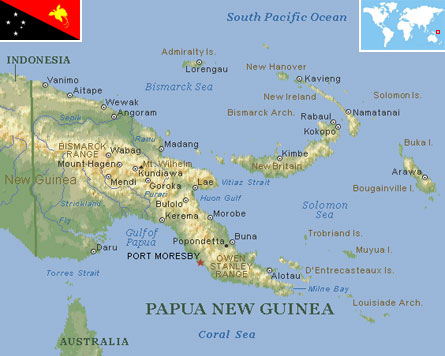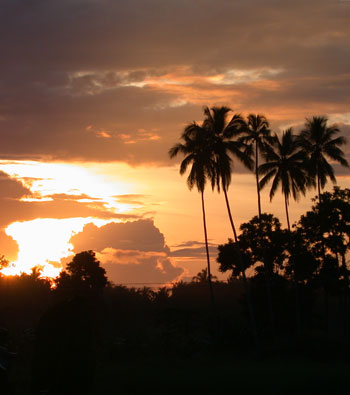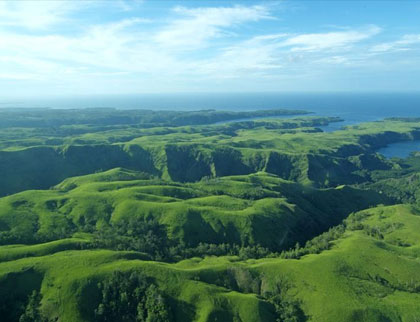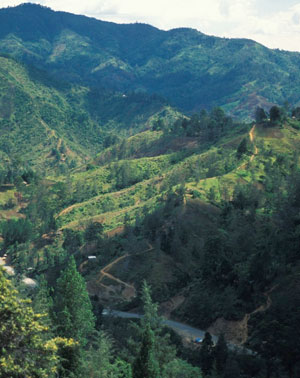Papua New Guinea
Country statistics

Land area: 174,849 sq miles (452,860 sq km)
total area: 178,704 sq miles (462,840 sq km)
Population (2011 est.): 6,310,129 (growth rate: 1.94%); birth rate: 25.92/1000; infant mortality rate: 42.05/1000; life expectancy: 66.46
Capital City: Port Moresby
Monetary unit: Kina
Languages: Tok Pisin (Melanesian Pidgin, the lingua franca), Hiri Motu (in Papua region), English 1-2%; 715 indigenous languages
Ethnicity/race: Melanesian, Papuan, Negrito, Micronesian, Polynesian
Religions: Roman Catholic 22%, Lutheran 16%, Presbyterian/Methodist/London Missionary Society 8%, Anglican 5%, Evangelical Alliance 4%, Seventh-Day Adventist 1%, other Protestant 10%, indigenous beliefs 34%
Country introduction

Papua New Guinea is located north of Australia and in the South-west Pacific Ocean on the eastern half of the rugged tropical island of New Guinea (which it shares with Indonesia, in the territory of Irian Jaya) as well as numerous smaller islands and atolls in the Pacific.
The central part of the island rises into a wide ridge of mountains known as the Highlands, a territory that is so densely forested and topographically forbidding that the island's local peoples remained isolated from each other for millennia. The coastline is liberally endowed with spectacular coral reefs, giving the country an international reputation for scuba diving.
The smaller island groups of Papua New Guinea include the Bismarck Archipelago, New Britain, New Ireland and the North Solomons. Some of these islands are volcanic, with dramatic mountain ranges, and all are relatively undeveloped.
The culture

It is estimated that more than a thousand different cultural groups exist in Papua New Guinea. Because of this diversity, many different styles of cultural expression have emerged; each group has created its own expressive forms in art, dance, weaponry, costumes, singing, music, architecture and more.
Most of these different cultural groups have their own language. People typically live in villages that rely on subsistence farming. To balance their diets, they go hunting and collect wild plants (such as yams roots) for food. Those who become skilled at hunting, farming and fishing earn a great deal of respect.
Sea shells are no longer the currency of Papua New Guinea, as they were abolished as currency in 1933. However, this heritage is still present in local customs; in some cultures, to get a bride, a groom must bring a certain number of golden-edged clam shells as a brideprice. In other regions, brideprice is paid in lengths of shell bead money, pigs, cassowaries and cash.
People of the highlands engage in colorful local rituals that are called "sing sings". They paint themselves, and dress up with feathers, pearls and animal skins to represent birds, trees or mountain spirits. Sometimes an important event, such as a legendary battle, is enacted at such a musical festival.
Attractions & landmarks

Papua New Guinea lies close to the equator and has Australia to its north. It is only one-ninth as big as Australia, yet it has just as many mammal species, and more kinds of birds and frogs. The area shelters above 600 islands and consists of an interesting mix of history and adventure that makes for a great vacation.
For a glimpse of the fascinating tribal cultures, the Highlands is the best place to visit as most of the mountains have traditional tribal village communities in the grassy valleys. The Central, Oro & Milne Bay Provinces are home to gorgeous reefs and historic wartime sites - including the country's foremost attraction, the Kokoda Track. Also part of these eastern provinces, the D'Entrecasteaux Islands are like the land that time forgot, mountainous, jungly and totally undeveloped. The gritty capital Port Moresby, on the other hand, is big and sprawling and consists of many attractions such as the Botanical Gardens, the Ela Beach Craft Market, Touaguba Hill and the Moitaka Wildlife Sanctuary.
Papua New Guinea is one of earth's megadiverse regions, and it owes much of its diversity to its topography. The mountainous terrain has spawned diversity in two ways: isolated mountain ranges are often home to unique fauna and flora found nowhere else, while within any one mountain range different species can be found even in the highest regions. In the lowlands are jungles whose trees are not that different from those of South-east Asia. Yet the animals are often startlingly different - cassowaries instead of tapirs, and marsupial cuscus instead of monkeys.
The country is neighbored by rivers such as Purari River and Fly River in the southern region and Ramu, Sepik and Markham in the northern part. Other natural attractions in this country include the mountainous range that segregates the New Guinea Highlands, Owen Stanley Range and Bismarck Range. Mount Wilhelm is the highest mountain peak in this region.